Relax in comfort,
Dulled by cushioning restraints,
You'll never stand tall
One of the original reasons I started to blog again was to document my experiences with standing desks (and standing in general at work and home). Of course, it's an entry that's months late by this point. I guess that'll be par for the course when it comes to my blogging efforts. Should've seen this one coming!
Those who have ever seen me play (or try to play) sports should know that I'm a fairly clumsy person. In my first intramural basketball game in high school, I had something like 5 or 6 turnovers, and I was swearing up and down the court that I was being fouled, but apparently I was just tripping over my own feet and gifting possessions to the other team. I'm no Jeremy Lin. Maybe more like his father after arthritis has set in. In any case, as a result of my two left feet, I've had my fair share of falls and injuries, particularly in my lower back. Four years crouched mostly over a computer monitor at MIT probably didn't help much either.
To date, I'm not sure I still completely buy into all the ergonomic sitting suggestions out there, but I knew by the end of my last year in undergrad that I had to at least try something different than what I was doing, especially with at least another 5 years of similar work to go. My first attempt at a standing solution was this PVC-based contraption I threw together out of about $15 of supplies:

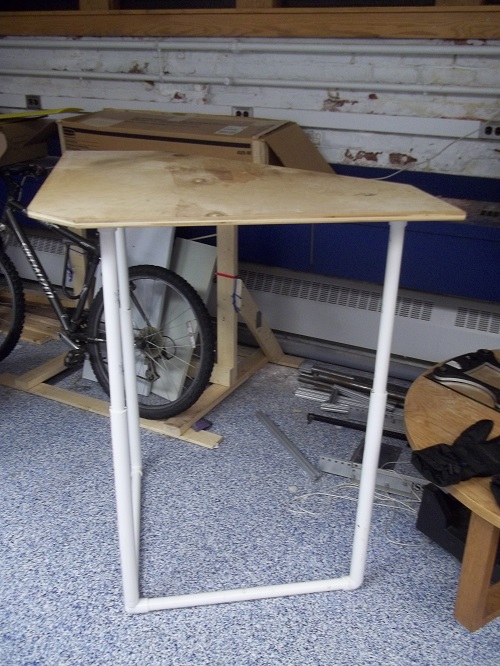
Everything was held together by wood screws and glue, and it was far flimsier than it looked. I thought I was being cute and used some quick-release button connectors to let me transition between standing and sitting. What I failed to realize at the time was that the whole thing was really difficult to transform when there was anything of significant weight on top of it (for example, a laptop and monitor). Incredibly, this was my primary table at home for the next two years. To this day, I actually still don't own a chair at home. I am an odd man with a rather strange life.
Meanwhile, I actually ended up doing a pretty extensive research on publicly available standing desk options. This was probably around the same time that standing desks really began to gain steam (mid-2011 or so?). The most affordable standing desks were either permanent solutions or small shelves that only had room for your keyboard. I didn't have the physical fortitude for the former and I couldn't take notes in my lab notebook with the latter. The best solution (even now) is probably a motorized desk that can shift between both modes, but there's no way I was willing to shell out the 1-2k for one while still in grad school.
My next attempt was with some heavy-duty hinges, 2x4's, and some random pieces of wood from Yale's loading dock (Protip: there's occasionally useful stuff to be found when other labs throw stuff out). The idea was that I could just fold out a platform for my keyboard, mice, and notebooks whenever I felt like standing. One downside wass that my monitors would always be at the same height, so I'd be slightly craning my head upwards (supposedly ergonomically non-optimal) whenever I sat down.
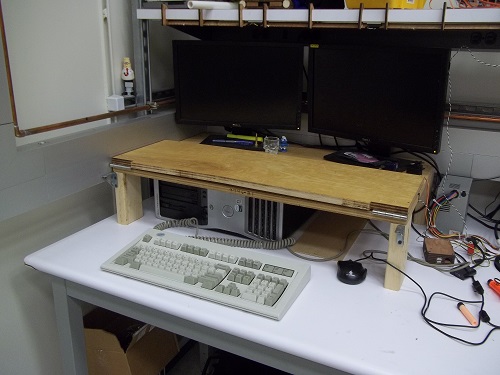
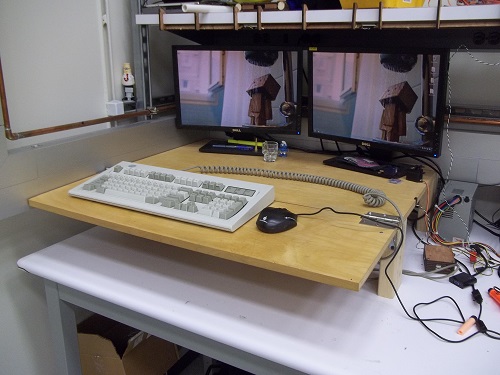
This version lasted close to a year. The panel that flipped outwards eventually warped over time. Apparently cantilevered beams deform under load. Who knew (sarcasm)? I put some thought into another fold-out design, but even considering bistable configurations or transformations that moved the platform through a kinematic singularity, I couldn't figure out anything that could give me a sturdy work surface. My final design, the one that I'm still currently using, is basically me waving the white flag, as it's super straight-forward. I got lucky with some Ikea Capita legs of varying heights and a pair of Ikea Linnmon table tops. Combined with some drawer slides off of Amazon and some corner brackets from Home Depot, and I had a sturdy, pull-out tray for whenever I wanted to transition to standing.
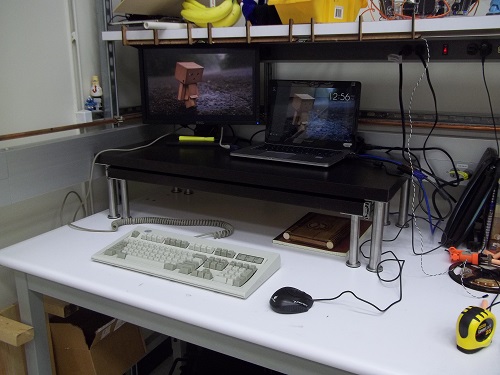
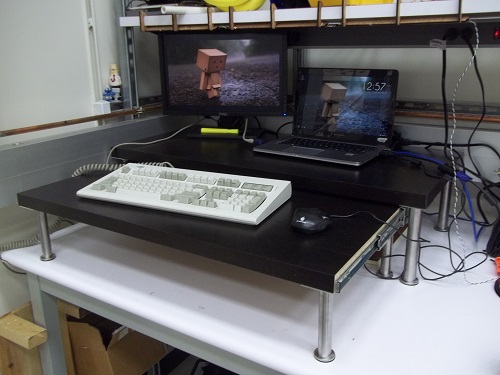
Currently, I usually start off my day sitting, transition to standing sometime in the mid-afternoon, go back to sitting a few hours later, and then possibly transition back to standing if I'm feeling a bit tired late at night and still want to get some work done.
*I should note that this assembly is placed on top of a lab bench that's already slightly elevated to begin with, so it's possible that this wouldn't work anywhere else.